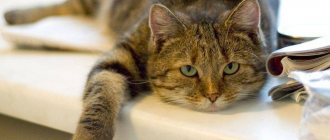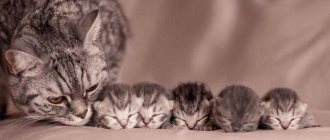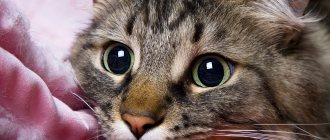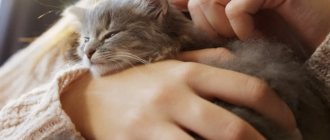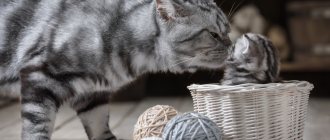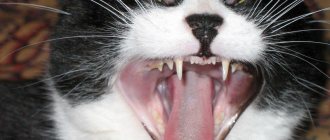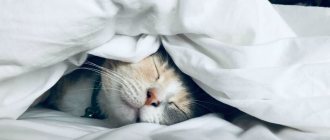What determines the duration of sleep in cats?
At all times, predator cats hunted and obtained food for themselves, which did not allow them to rest for a long time, as domestic cats do. Pets that live at home side by side with people do not have such a need, and therefore they spend their free time sleeping. On average, domestic cats sleep about 16 hours a day, but depending on various factors, sleep duration can vary from 14 to 22 hours. This should not alarm the owners.
Constantly being in a state of sleep is the norm for cats
During sleep, your pet's brain and sensory organs continue to work as actively as during wakefulness. The environment is actively analyzed for danger, and the animal is always ready to wake up at any moment. Therefore, in reality, a cat’s sleep is quite superficial, it lasts about 4–5 hours and is replaced by periods of activity.
The length of a cat's sleep depends on the following factors:
- age. Newborn kittens sleep almost constantly, while an adult cat sleeps much less. Older individuals also have long sleep periods;
- satiety. If a cat eats a large amount of food, it can sleep for up to 20 hours after each meal;
- psychological comfort. When a cat is stressed, the number of hours of sleep may be reduced or minimized. After suffering stress, the daily routine soon returns to its usual rhythm;
- weather. Hot weather is difficult for cats to endure while awake, and therefore they mostly sleep;
- health. Sick pets sleep much more than those without health problems;
- sexual stimulant. Cats in heat are very active.
How long do cats sleep depending on age?
Immediately after birth, the kitten sleeps for about 23 hours a day and wakes up only to feed. Often the baby falls asleep with his mother, because he feels safe next to her. By sleep you can determine whether the kitten has enough food. If after eating he immediately falls asleep, it means that his mother’s milk is enough for him. If the baby squeaks and cannot sleep, then it is necessary to start additional feeding.
If a kitten sleeps up to 22–24 hours a day and is lethargic, refuses to eat and moves little, you should pay attention to its health.
When a kitten reaches the age of 2-3 months, it begins to actively explore the world around it, its physical activity increases, and its sleep time decreases to about 20 hours.
Sleep is one of the important factors influencing the formation of a healthy kitten’s body.
An older cat spends less time sleeping than a kitten. But don’t worry if your pet spends more than 20 hours a day sleeping. For each individual and breed, sleep time is individual. Older cats seem to relapse into childhood and can sleep almost all day long as their physical activity and needs decrease.
Long sleep and its causes
There are several reasons for prolonged sleep. If they are not associated with general lethargy and refusal to eat, then they are considered normal.
Cats are naturally very active. It is vital for them to replenish their strength and sleep is the best medicine for this.
Again, returning to natural premises, it should be noted that in nature, cats are predators. Their main diet consists of food rich in proteins. Pets also eat mainly protein foods, which require a long time to digest.
After sterilization, your cat may sleep longer than usual.
Cat sleep phases
Cat sleep has two phases: slow and fast sleep. NREM sleep is very similar to napping. During this phase, the cat may quickly and abruptly wake up from touch or loud noises. NREM sleep is also called low-wave sleep because the animal's breathing and heart rate are slow despite muscle tension. During this phase of sleep, the cat's metabolism decreases, and blood pressure and temperature drop.
Sleep among our furry friends is divided into two completely different types.
The second stage of sleep is REM or deep sleep. During this period, the cat's eyeballs rotate rapidly. This type of sleep occurs 10–30 minutes after the start of slow-wave sleep. During REM sleep, the pet does not control its muscles and may fall if it chooses an insufficiently comfortable place to rest. But despite the relaxation, the cat may twitch, change sleep positions, grumble and, in rare cases, even extend its claws. Interestingly, the pet’s brain activity does not decrease during deep sleep. Scientists have found that REM sleep is just as energy-consuming as being awake.
After sterilization
It should be noted that after sterilization surgery, the cat does not eat and sleeps all the time; this is a normal state after anesthesia. If this period lasts for 24 hours, then there is nothing to worry about. If a day has passed and the condition does not change, you need to urgently see a veterinarian.
During the first 24 hours, you don’t need to force the cat to get up or wake him up if she doesn’t want to. Just like insisting on food and drink. Give her a little rest, recover, and she will again delight you with her cheerful appearance.
If the anesthesia has not worn off and the cat is not sleeping, gets up and tries to move around the apartment, do not let it out of sight so that it does not accidentally get injured. It’s better to take her in your arms, calm her down, and maybe she’ll fall asleep. Sleep is the best medicine here.
Favorite vacation spots
Cats choose a place to sleep carefully: it should be quiet, comfortable and cozy. It is important for an animal to always have access to its favorite place and know that it will not be disturbed there. That’s why your furry pet often chooses secluded corners for relaxation: armchairs, sofas, beds, and even the shelves of an open wardrobe. Cats usually have several favorite places, which they happily alternate. Despite the careful choice of sleeping place, sometimes pets sleep where they fell asleep after a hearty lunch. For example, on the floor, on the refrigerator or in other unusual places.
Sometimes cats choose unusual places for bed
A cat's dream close to its owner speaks of sympathy and affection. Pets love to settle next to a person while sleeping: at the head of the bed, at the foot of the bed, at arm's length, or on the owner himself. Sometimes, when choosing a place to rest, a cat is guided by the desire to be closer to the warmth, and therefore settles down near the heaters.
Do cats dream?
In the middle of the last century, scientists found that mammals dream in the REM sleep phase. At this time, the muscles are paralyzed by the varolian trunk of the cerebral cortex, which does not allow the body in reality to repeat the movements seen in a dream.
The pons contains nerve fibers that connect the two halves of the cerebellum
In 1965, somnologists from France Michel Jouvet and J.-F. During an experiment, Delorme removed the varicose veins of cats and obtained an interesting result. In the dream, the cats began to move in space, show aggression, move as if they were hunting, and rush at invisible mice. At the same time, they ignored real mice, which suggests that at those moments the cats were in the world of dreams.
After Jouvet and Delorme, neurophysiologists from the University of Lyon began studying the dreams of cats. Their research showed that most cat dreams involve various emotions, exploration, personal hygiene and hunting.
Stages
The pet's sleep process is divided into the following stages:
- Nap. The body remains conscious and alert during rest. In the event of an unexpected threat, the animal reacts instantly.
- Shallow sleep. The body rests, but hearing is preserved.
- Deep dream. Muscle tension disappears, short nerve impulses may be observed, due to which the muscles contract and the paws twitch.
- REM phase. The eyes move behind closed eyelids, there is a high probability of dreaming.
The first two stages last about half an hour, followed by 5-7 minutes of a deep phase, which again gives way to sleep. This alternation of stages of sleep allows the animal not to lose vigilance and control the situation around itself at all times.
What to do if your pet gets less rest
If you notice that your pet has begun to spend much more time in an active state, you need to pay attention to its physical and mental health. During sleep, the strength of any living organism is restored, but if after sleep the cat looks sleepy and lethargic, it needs to be taken to the veterinarian. Problems with the thyroid gland can cause a shortened rest period. If all the pet’s organs are in order, pay attention to its psychological comfort. Causes of stress can be, for example, moving or adding another pet to the house. In this situation, only time will help: in a couple of days the cat will get used to the new environment, and his sleep will return to normal.
Short rest is harmful for cats, so if you notice that your pet is not getting enough rest, make an appointment with your veterinarian
How you can help at home
If lethargy is combined with poor appetite (the animal asks to eat, but does not eat), then perhaps the cat does not like the food that is offered, or does not like the bowls or their condition. Try replacing food and dishes.
Assess the temperature and humidity in the house; perhaps the animal is cold or hot. If the cat is recovering from vaccination, anesthesia, or has recently become pregnant, then nothing additional needs to be done. Gradually the condition returns to normal.
If you are sure that the changes are caused by stress, then communicate more with the animal. Talk, stroke, pick up, play. Buy your pet a new sports complex or a new toy.
Veterinarians do not recommend self-medication and delaying a visit to the doctor. If you are sure that the lethargy is not caused by a recent vigorous game, a heavy dinner, or something similar, then you need to see a doctor as soon as possible. The specialist will study and evaluate the symptoms, and the treatment prescribed by the doctor will help save the animal’s life.
What to do if your pet sleeps too much
If long sleep does not fit into your pet’s daily routine, but he suddenly begins to rest for a long time, you should be wary and also take a closer look at his health. In addition to drowsiness, the disease is indicated by the presence of the following symptoms:
- increased water consumption or refusal of it;
- lack of appetite;
- lack of response to external stimuli;
- diarrhea;
- vomit;
- false urge to urinate.
The presence of at least one of the listed symptoms indicates the need to visit a specialist. If these symptoms are not present, it may be due to the weather: cats, like people, can be weather dependent and feel sleepy on certain days.
Long sleep: normal or pathological?
In general, only a veterinarian can make conclusions about a pet’s health. Perhaps the cat is sick, and sleep is a consequence of malaise, weakness and loss of strength.
A kitten, a small cat sleeps all the time and this is normal. Her sleep may be interrupted by short games and food. At the same time, during rest, he can twitch his paws and squeak quietly. Don't worry, these are signs of emotionality experienced during the day's events.
Experts believe that the number of hours a pet naps and sleeps is greatly influenced by weather conditions . Since thermoregulation is important for animals, in the summer, especially on hot days, the rest period may increase and it will seem that the cat is sleeping all day.
A combination of drowsiness and lack of appetite should alert you. Then you definitely need to take your pet to the vet.
In general, long-term sleep is normal for cats, as long as there are no obvious behavioral abnormalities or problems with appetite or bowel movements during wakefulness.

